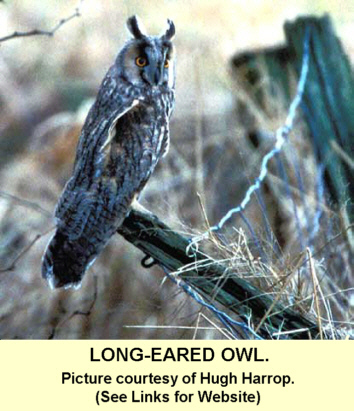
LONG-EARED OWL. Asio otus 
IDENTIFICATION. The Long-eared Owl, as the name suggests, has two prominent ear tufts. The scientific name translates as 'Horned owl with ears'. These tufts (not real ears) are generally used for display or as an aid to camouflage.
The plumage is mottled with streaks both front and back and is not dissimilar to the eagle owls. The body is narrower than the Tawny Owls and the orange, rather than black, eyes help with identification.
At rest the Long-eared Owl is commonly confused with the Tawny Owl. Its flight is similar to the Short-eared Owls.
IN FLIGHT. The Long-eared Owl has a wavering style of flight similar to the Short-eared Owl. The difference is visible in the plumage with the Long-eared having a darker underneath, with greater streaking. The spring display flight includes noisy wing clapping.
DISTRIBUTION. A coniferous woodland bird found in Scotland, Ireland, the North and East of England. Scarce in the south and west. Hunts over rough open grassland.
WHEN SEEN. All year round.
FOOD. Generally small mammals, including shrews, water voles and rats. Birds to the size of Jays.
BREEDING. March-April. 4 to 5 eggs laid in abandoned corvid nests. Young hatch after 27-28 days, flying 23-24 days later.
SIZE. 36cm (14in)
CALL. oo-oo-oo
FALCONRY.
Not generally used in falconry. However if the long-eared owl is to be kept they need a good size aviary, not a parrot cage, and company if not flown regularly.
NB. If you buy one of these raptors it should be fitted with a closed leg ring and have an Article 10 form with it (any queries check with DEFRA).
Falconry marks
